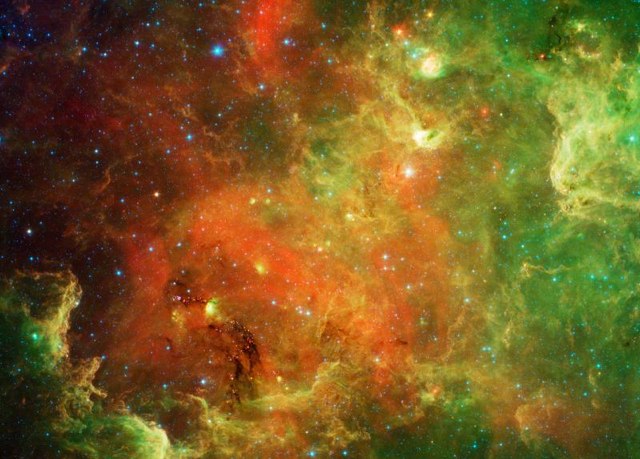You could while away an entire afternoon just exploring one small patch of this single image. You won't, unfortunately, be able to resolve individual details as small as planets, but you will be able to get a sense of the scale and grandeur that lurk in the origins of every lowly rock and square inch of our own planet. To actually see planets mid-formation, you won't have to wait too long, though. A new, ambitious radio telescope array in Chile, the Atacama Large Millimeter Array (ALMA), is steadily approaching full operational strength. And this particular piece of kit, once it's up and running, will be able to provided deep, high-resolution views of the interiors of accretion disks. The upcoming James Webb Space Telescope will help, too, but you'll probably have to wait a bit longer for that, since it won't be launching any earlier than late 2015.
The point is, as beautiful as this Spitzer image is, it's only a preview of what we're likely to see and learn about our deepest planetary origins in the next decade.
One reason I like writing about space science is because it offers so many gorgeous, mind-blowing images. Each and every day replica oakley sunglasses, they pulse from observatories that dot the Earth, and trickle down from our probes in the sky. The flow of visual data is already too much for our planet's limited number of professional astronomers, and is only set to ramp up further in the immediate future as multiple new deep-looking telescopes and all-sky surveys come online. This means there will be more and more opportunities for amateurs, average folks with just a bit of time and interest, to make real discoveries by sifting through images that the pros didn't have time to closely examine.
The most amazing thing is, you can actually see a lot of this stuff happening when you download one of the high-resolution versions of this image and zoom around its different parts.
A good example of the visual depths waiting to be plumbed is this new image of the North America Nebula from NASA's infrared Spitzer Space Telescope. The North America Nebula is an emission nebula, essentially just a huge cloud of dust and molecular hydrogen that has been partially ionized and lit up by massive stars somewhere deep inside it. It doesn't seem that interesting until you actually look at it, preferably in multiple wavelengths. The thicker clumps of gas and dust occlude light at optical wavelengths, masking processes taking place inside, but infrared light can pass straight through these regions, revealing their mysterious inner workings. And we really want to know what's taking place there, because in all likelihood our Sun and its planets formed in a nebular cloud very much like this one.
Each little pinpoint speck of light in Spitzer's image is a young star at some particular point in its development. Some are still undergoing their initial gravitational collapse, and haven't even become true stars yet—that only occurs when thermonuclear fusion kicks off in their cores. Others have begun their stardom, but are still sheathed in spherical cocoons of gas and dust, shells of material that will gradually grow puffy and vaporous from the inner star's light and heat, until they whisper away on stellar winds. Many of these points of light are ringed by thick accretion disks of material that formed from the angular momentum of their initial gravitational collapse. Sometimes parts of the disk get sucked too close to the star, and are shocked into plasma and spun away and out from the star's poles in powerful collimated jets that can sculpt and shape the surrounding gas and dust into abstract whorls and tendrils. And, in the background, almost unnoticed against all the stellar fireworks, in all probability planets are slowly and surely forming. Perhaps, on a few them, the seeds of life are already being sown by comets and meteorites, the infalling detritus of star formation delivering water and complex chemical compounds brewed in the stellar clouds.
Lee Billings at 12:20 pm Thursday coach outlet, Feb 10 http://coachfactorystore-bag.weebly.com
http://coachfactorystore-bag.weebly.com
没有评论:
发表评论